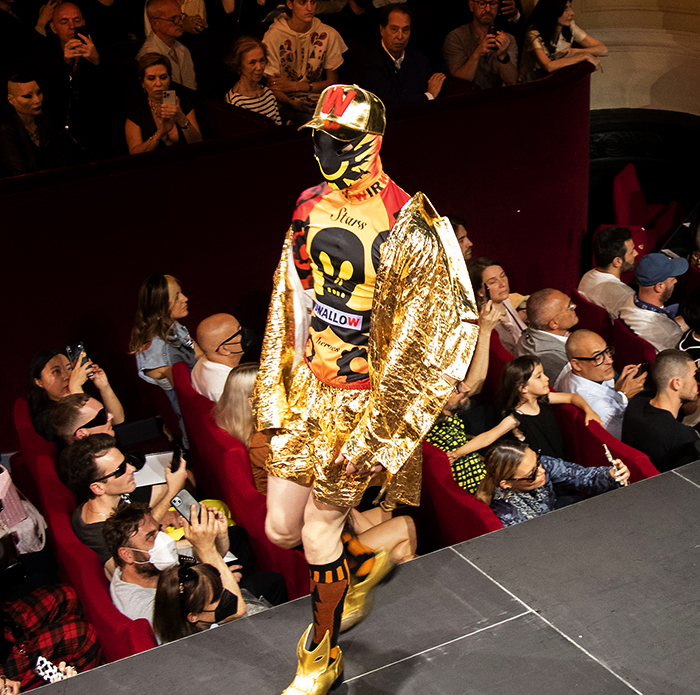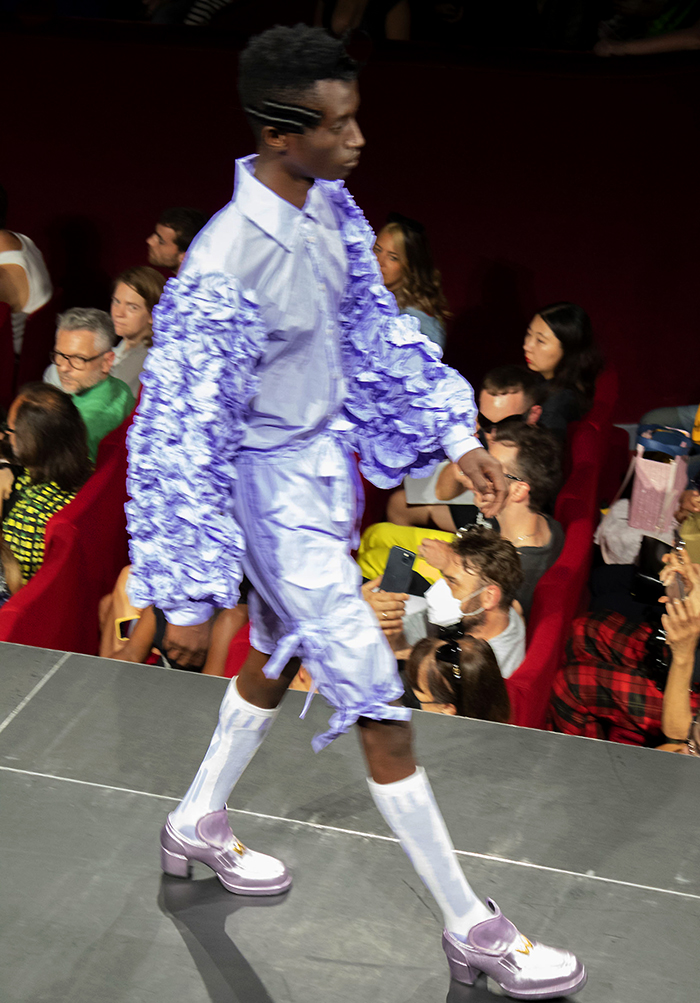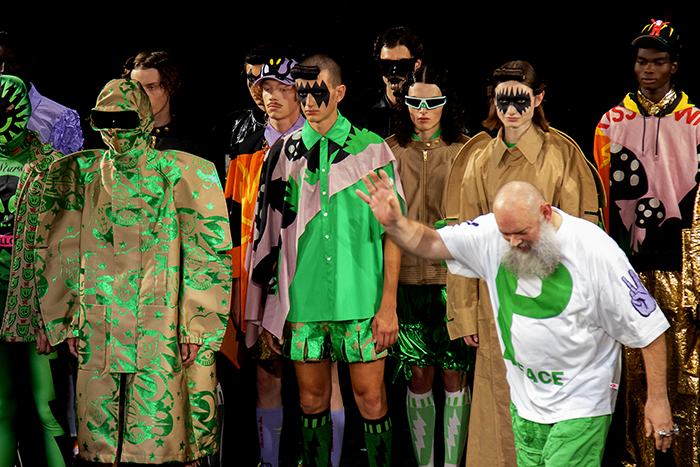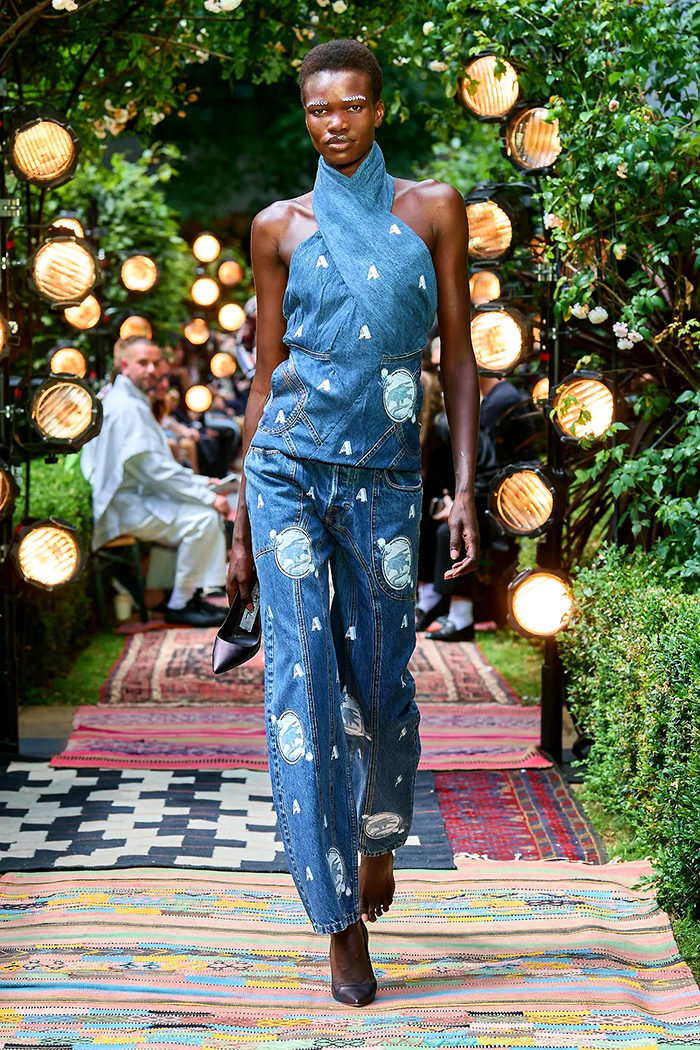Wednesday, 13 July 2022
Saturday, 25 June 2022
Parish Fashion Week: Walter Van Beirendonck Spring/Summer 2023
 |
| Brilliant colours, unique silhouettes and wonderful sleeves at Walter Van Beirendock's Spring/Summer 2023 show in Paris. Cover picture and all photographs by Elli Ioannou for DAM. |
 |
The shrouded figures that opened the show at the Théâtre de la Madeleine in Paris. |
 |
The designer's contemporary doublet sleeve with metallic ruffles. |
Subscribe to support our independent and original journalism, photography, artwork and film.
Thursday, 16 June 2022
Ahluwalia's Bold and Bright Spring/Summer 2023 Collection
 |
| The leafy setting of the Salter's Hall Garden in London was the backdrop for the new Ahluwalia SS23 show. |
PRIYA Ahluwalia originally founded her eponymous label as a menswear brand but added womenswear to her collections last season. Born in London, the designer is inspired by her Indian-Nigerian heritage and launched her fashion company in 2018. Integral to her design ethos are repurposing materials and finding different ways to examine black identity. This season she explored further afield, aiming to bring forth the heterogeneity of the African continent and all of its cultural individuality, calling the new collection Africa is Limitless.
"It is inspired by everything from weaving, to their many superstar musicians, to the technicolour Sapeurs and album covers from Cote d'Ivoire," notes the designer. "Beaded elements draw on sources of inspiration from Kenyan and Rwandan cultures. Gorgeous patterns seen in old vintage museum blankets from Tunisia inspire a respectfully redrawn and reinterpreted likeness in knitwear, and other vintage textiles inspire unique prints."
Presented during London Fashion Week, the Spring/Summer 2023 Ahluwalia show was held amid the greenery of Salter's Hall Garden which was a foil to the brilliant colour of the designs she sent down the leafy runway. Colourful and voluminous head wraps completed looks which included an intriguing mix of athleisure and tailoring. The designer's bold patterns added to the vibrancy and vividness of the collection and made elusive references to the many African countries she studied before designing this season's show. ~ Giacomo de Rothschild
Subscribe to support our independent and original journalism, photography, artwork and film.
Saturday, 23 April 2022
Renaissance Man: Raphael as Artist, Architect and Archaeologist
 |
| Raphael's luminous Saint Catherine of Alexandria, about 1507. Photograph: ©The National Gallery, London |
A major new exhibition of the superlative Renaissance artist, Raphael, has opened at the National Gallery. Painter, architect, designer and archaeologist, the show has 90 exhibits of his work from celebrated paintings and drawings to lesser-known poetry and designs for sculpture, tapestry, prints and the applied arts. Antonio Visconti reports from London
 |
| Raphael: The Garvagh Madonna, about 1509-10 Oil on wood 38.9x 32.9 cm © The National Gallery, London |
 |
Raphael: Study for the Head of an Apostle in the Transfiguration. ©Private Collection, New York |
 |
| Raphael: An Allegory, Vision of a Knight about 1504. Oil on poplar 17.1 x 17.3 cm ©The National Gallery, London |
 |
Cesarino Roscetti: The Incredulity of St Thomas Bronze, 88.5cm . Courtesy: Ministero per i beni e le attivita culturali |
 |
Raphael: Madonna of the Pinks, (La Madonna dei Garofani) about 1506-7 Oil on Yew 27.9 x 22.4 cm ©The National Gallery, London |
 |
Pieter Coeckle van Aelst: Vision of Ezekiel c1521, Tapestry, 440 x 337 cm ©Museo Nacional de Artes Decorativas Madrid |
Raphael is at the National Gallery, London, until 31 July 2022.
Subscribe to support our independent and original journalism, photography, artwork and film.
Thursday, 24 February 2022
Yuima Nakazato's Brave New (Fashion) World
 |
| Yuima Nakazato's vivid SS22 haute couture collection in Paris. All photographs and cover picture by Elli Iannou for DAM |
 |
Contemporary dancers move amid clouds of dry ice as a model emerges from the gloom in brilliant, butterfly-wing hues |
Clouds of dry ice billowed around Rococo wooden doors with wraith-like dancers clad in white forming a moving chorus to the models emerging from the gloom. Locks of brightly- coloured hair and elfin pointed ears accompanied Nakazato's voluminous, draped creations.
"This season was mainly about focusing on the physical fashion show," the designer said. "These two years of digital shows made me really miss Paris. It was very tough to decide to fly to France but I really wanted to present the show. "
The designer was inspired by the chimera, a mythical creature made up of different animals. Originating in Greek mythology, the chimera was a fire-breathing hybrid creature, from Lycia in Asia Minor. Often depicted as a lion, the chimera had a goat head protruding from its back and tail ending with a snake's head. Although the designer didn't use the image of the chimera literally, he saw it as a symbol of bringing myth and legend into his latest collection.
"This season was all about the physical fashion show. These two years of digital presentations due to the pandemic made me really miss showing in Paris. "
 |
Nakazato's experimentation with new fabrics make his collections a stand-out at haute-couture week in Paris |
In practical terms, this meant the designer mixed the latest technological advances in materials with traditional techniques, such as using a kimono embroiderer to embellish his creations.
"The title "liminal" means something in the middle, a very abstract and unclear area, between say man and woman, artifice and Nature or East and West," the designer said. "That was the starting point of the collection. It is philosophical but very important to me. For example, the Japanese kimono has a rectangular shape and although it is not the shape of the human body, everyone can wear it. This is an interesting concept. I have tried to mix couture with this Japanese kimono philosophy. I wanted to tie them together and express this in the collection."
Yuima Nakazato has made it his mission to be at the forefront of experimenting with new materials and techniques. He is still developing his in-house production system, Biosmocking, which has no material waste from the production process and does not use a needle and thread to create garments.
It is a cutting-edge technology making clothes via a digital fabrication of textiles made from artificial protein. The designer uses these natural materials including "brewed protein" which is made from using the artificial protein created by Japanese bio start-up Spiber.
The designer likes to mix the latest technological advances in materials with traditional techniques
 |
Brightly-hued, asymmetrical wigs and elfin ears add to this season's sense of fantasy |
Nakazato strives to look at the big picture, he says he wants to realise "a new vision for humanity" through clothes. His designs made from the plant-derived sustainable materials, represent an important step away from the current widespread reliance on petroleum-based resources. Nakazato is one of the rare avant-garde designers who don't just experiment with style but uses his own radical manifesto for the future. The new textile created from the brewed protein is a sustainable fibre made by a fermentation process.The textiles are created by fabricating the artificial protein.
As its production doesn't rely on petroleum, brewed protein is biodegradable and could offer a sustainable solution for the fashion industry. Ecologically-minded apparel manufacturers are moving away from micro plastics and animal-derived materials. Protein-based polymer materials are energy efficient, environmentally friendly and economic to produce. The designer believes these innovations in materials and technology are the direction in which haute couture should be moving.
Yuima Nakazato is one of the rare avant-garde designers who don't just experiment with style but create a radical manifesto for the future
 |
The designer used his Type-1 technique in the new collection that make his clothes customizable |
This is all part of Yuima Nakazato's design ethos about fashion's social responsibility: "I believe that the evolution of garments will lead to a richer human society. To fulfil our responsibility towards future generations, we conduct ongoing assessments of our material supply chains and we create garments designed for long-term use and eventual up-cycling."
Another element in the new collection that the designer has explored in previous seasons is what Nakazato calls the Type-1 system. This enables parts of clothes to be replaceable.
In Paris, he wore a shirt where the sleeves and collar could be changed just by undoing a series of rivets. This makes his clothes completely customizable and was incorporated into the Spring-Summer 2022 couture collection.
The designer believes this revolutionary new technology for making digital couture will allow custom-designed clothes to be accessible to everybody and make couture clothes available to all. "I want to give the experience of having a uniquely designed piece to everyone," he said.
But the designer said the big question is how to do this. Obviously haute couture is very expensive and mass production is very cheap. And the customer cannot communicate to the designer. So Nakazato thinks technology could provide a solution and help realize his idea. He said that "haute couture has the best design but wearing it is not possible for everyone, it is my aim to find a solution to that."
"I believe that the evolution of garments will lead to a richer human society."
 |
Nakazato uses the latest technology and traditional kimono embroidery to bring old and new together |
The designer has often said he believes that couture is the future of fashion. "This type of technology is sustainable, so if your body changes you can customize the clothes.
"If you damage some part of it you can just change it ~ so you don't just throw it away. The clothes become like another skin and you can even give it to your daughter, just changing the design and size."
In the Type-1 system, instead of a traditional fitting where the body is measured, the wearer is scanned through a device before numbered squares of digitally cut fabrics are riveted together to form a perfectly fitting piece. Nakazato said the major discovery was finding a way to use everyday fabrics like cotton, nylons and wool which are difficult to control using digital fabrication.
"That was the most difficult part," he said. "But in the end we succeeded. We can design every type and shape of garment to be a precise fit to the wearer's figure. Digital fabrication is very useful mainly for PVC, rubber or plastic. But I wanted to use traditional fabrics and although these are hard to control using digital tools we found a way of doing it.
"We assess our material supply chains and we create garments designed for long-term use and eventual up-cycling."
 |
Vivid colours made the designer's pantsuits and tunicslook like the wings of exotic birds |
"With this system we are now able to build all silhouettes imaginable," Nakazato explained. "It is like creating a garment from a dress pattern but with even more flexibility."
While the designer has admitted that his work is very much at the experimental stage, he insisted that "future mass customisation" is possible. "There is still a lot of work by hand in putting the clothes together," Nakazato explains.
"It is like technology and craftsmanship combined." The designer says that aesthetically his digital creations still had a long way to go to reach the perfection of classic haute couture which must be made by hand.
For the Spring-Summer 2022 collection, the designer included both ready-to-wear and haute couture designs. There were long black and white tunics worn with vividly-coloured capes. The palette of electric blues and greens contrasted with glowing reds and yellows like the brilliantly-hued wings of Australian lorikeets. The asymmetrical wigs and long elf ears added too the otherworldly vibe. The long tunics were worn with cords and combined with colourful prints, tie-dyes and knits.
For the Spring-Summer 2022 collection, the designer included both ready-to-wear and haute couture designs
 |
Draped 3D fabrics and silky knitted materials added to the sense of beauty and fantasy of the collection |
Yuima Nakazato first began to be interested in fashion as a student because at his high school in Japan they could choose to wear whatever they wanted, unlike most Japanese schools where a uniform is de rigueur.
"I liked looking at fashion magazines ~ there was no Internet then ~ so we were reading magazines and seeing the "street snaps," a very typically Japanese part of culture with pictures of people standing on the street which I really liked."
But he decided that fashion would be his career after seeing the first Japanese designers graduating from the Royal Academy Antwerp in 2002.
"I saw their graduate collections in the newspaper and they looked so colourful and interesting I was shocked. Seeing these designs changed me dramatically and inspired me to go into the fashion world more deeply and immediately I decided to do Antwerp's fashion degree as well."
"I liked looking at fashion magazines and seeing the street snaps which is a very typical Japanese part of culture."
 |
Designer Yuima Nakazato ran out to take his bow in Paris before racing backstage |
Nakazato was the youngest Japanese student to graduate from the Fashion Department Master’s Course at the Royal Academy of Fine Arts Antwerp. So ahead of their time were his shoe designs, during his degree show, that they were acquired by the Antwerp Mode Museum (MoMu) for their permanent collection. He was also awarded the Innovation Award by Ann Demeulemeester for his graduate collection and he won the International Talent Support (ITS) Fashion Competition held in Italy, one of the two largest fashion contests in the world
Today, when Nakazato is designing a new collection in his Shibuya studio, he begins with key words and a story as a starting point like this season's chimera, afterwards he begins the research. But always his ultimate aim for every collection is the search for ways of creating fashion that makes people feel happier.
"That is why I would like the clothes of the future to all be unique and different as I think that makes everyone feel good. Right now we have to wear mass produced clothes because of the cost. But that is all changing with this new technology and it makes for a very interesting moment in fashion."
Subscribe to support our independent and original journalism, photography, artwork and film.






































